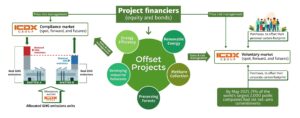Carbon Trading Start
The first formal carbon market was part of the Kyoto Protocol, an international agreement to limit greenhouse gas emissions. More than 150 nations signed the agreement. They were required to cut their greenhouse gas emissions by 5 percent below 1990 levels. In addition to reducing the emissions of CO2, the parties also agreed to sell excess emission units, known as CERs. These credits have become so important that a thriving industry has emerged around the business of certifying and marketing them.
However, the initial stage of the ETS carbon trading was a period of trial and error. This involved determining the best pricing mechanism. The Environmental Protection Agency had already failed with previous experiments with emissions trading. Among the reasons were the complicated system of credits and permits.

A key idea was to give companies incentives to reduce their emissions. They could buy scrubbers or other technology to reduce their emissions, or they could switch to cleaner fuel. Ultimately, the government would impose a cap on the amount of emissions that each company can release.
When Did Carbon Trading Start?
Companies were then given a certain number of tons of allowances at the beginning of the year. If they exceeded the amount allowed, they had to find another way to offset their emissions. Sometimes they might buy more allowances on the open market. Other times they might restrict output, or they might simply stay under the cap.
As the global financial crisis worsened, the demand for carbon allowances decreased. This made the price of these credits soar. So, to avoid losing their value, some companies began searching for more allowances.
Ultimately, the federal government implemented a national emissions trading scheme, which became the first of its kind in the United States. After a three-year pilot program, the full-scale national ETS was introduced. By mid-December, real trading had begun.
Carbon trading is just one of many interim solutions to the climate crisis. Other solutions include lowering the use of fossil fuels, switching to renewable energy sources, and increasing efficiency. Nonetheless, a growing industry has sprung up around the certification and marketing of carbon credits.
The Paris Agreement of 2015 has led to the development of national and subnational carbon markets. These markets help mitigate the effects of the climate crisis and create new market opportunities. For example, the Western Climate Initiative is a collaborative effort between California and Quebec that aims to increase access to affordable energy. It was formed by a group of environmental and business leaders, including the governors of both states.
Another form of emissions trading is known as a “cap and trade” program. These programs are designed to lessen the burden of a country’s efforts to meet its emission reduction targets. Rather than limiting the amount of CO2 that a company can release, cap-and-trade allows it to do so by giving it a price to pay for the emissions.
The biggest market for carbon emissions is the European Union’s Emissions Trading System (ETS). This program has been in place since 2005. Over the next five years, it is expected to lower its emissions by five percent.
